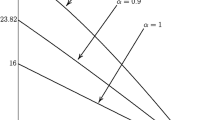Abstract
Nonmarket goods include quality aspects of market goods and public goods which may be substitutes or complements for private goods. Traditional methods of measuring benefits of exogenous changes in nonmarket goods are based on Marshallian demand: change in spending on market goods or change in consumer surplus. More recently, willingness to pay and accept have been used as welfare measures. This paper defines the relationships among alternative measures of welfare for perfect substitutes, imperfect substitutes, and complements. Examples are given to demonstrate how to obtain exact measures from systems of market good demand equations.
Thanks also to the very helpful anonymous reviewers for Social Choice and Welfare.
Similar content being viewed by others
References
Bergland O, Randall Al (1984) Operational techniques for calculating the exact Hicksian variations from observable data. Staff Paper 177, Department of Agricultural Economics, University of Kentucky
Bockstael NE, McConnell KE (1983) Welfare measurement in the household production framework. Am Econ Rev 73: 806–814
Bradford D (1970) Benefit-cost analysis and demand curves for public goods. Kyklos 23: 775–791
Bradford DF, Hildebrandt GG (1977) Observable preferences for public goods. J Publ Econ 8: 111–131
Chipman JS, Moore JC (1980) Compensating variation, consumer's surplus, and welfare. Am Econ Rev 70: 933–949
Currie JM, Murphy JA, Schmitz A (1971) The concept of economic surplus and its use in economic analysis. Econ J 81: 741–799
Deaton A, Muellbauer J (1980) Economics and consumer behavior. Cambridge University Press, Cambridge
Freeman AM (1979) The benefits of environmental improvement. John Hopkins University Press, Baltimore
Hanemann WM (1979) Quality changes, consumer's surplus, and hedonic price indices. Unpublished manuscript. Giannini Foundation, University of California at Berkeley
Hause JC (1975) The theory of welfare measurement. J Publ Econ 83: 1145–1182
Hausman JA (1981) Exact consumer's surplus and deadweight loss. Am Econ Rev 71: 662–676
Hurwicz L, Uzawa H (1971) On integrability of demand functions. In: Chipman JS, Horwicz L, Richter M, Sonnenschein H (eds) Preferences, utility, and demand. Harcourt, Brace, Jovanovich, New York, pp x-x
La France JT (1986) The structure of constant elasticity demand models. Am J Agric Econ: 543—551
Lankford RH (1983) Exact consumer's surplus for changes in imposed quantities. Unpublished paper, State University of New York at Albany
Maler K (1974) Environmental economics, John Hopkins Press, Baltimore
McKenzie W (1983) Measuring economic welfare: New methods. Cambridge University Press, Cambridge
McKenzie GW, Pearce IF (1984) Welfare measurement. A synthesis. Am Econ Rev 72: 669–682
Mishan EJ (1969) Welfare economics. Random House, New York
Ng YK (1980) Welfare economics: Introduction and development of basic concepts. MacMillan, London
Phlips L (1974) Applied consumption analysis. North-Holland, Amsterdam
Prest AR, Turvey R (1965) Cost-benefit analysis. A Survey. Econ J:683—735
Randall A, Stoll JR (1980) Consumer's surplus in commodity space. Am Econ Rev 70: 449–455
Ridker RG (1972) Economic costs of air pollution. Praeger, New York
Silberberg E (1972) Duality and the many consumer surpluses. Am Econ Rev 62: 942–951
Takayama A (1984) Consumer's surplus path independence, compensating and equivalent variations. J Institut Theoret Econ 140: 594–625
Varian HR (1984) Microeconomic analysis. WW Norton, New York
Vartia Y (1983) Efficient methods of measuring welfare change and compensated income in terms of ordinary demand functions. Econometrica 51 (11): 79–98
Water Resources Council, Water and Related Land Resources, Establishment and Principles and Standards for Planning Federal Register 38 (174) (Sept. 10, 1973), Part III, pp 1—167
Willig RD (1976) Consumer's surplus without apology. Am Econ Rev 66: 589–597
Willig D (1978) Incremental consumer's surplus and hedonic price adjustment. J Econ Theory 17: 227–253
Author information
Authors and Affiliations
Additional information
Thanks to Professor Deb Brown, Purdue University, for her encouragement and help over the period in which this paper was written.
Rights and permissions
About this article
Cite this article
Loehman, E. Alternative measures of benefit for nonmarket goods which are substitutes or complements for market goods. Soc Choice Welfare 8, 275–305 (1991). https://doi.org/10.1007/BF00183041
Received:
Accepted:
Issue Date:
DOI: https://doi.org/10.1007/BF00183041




